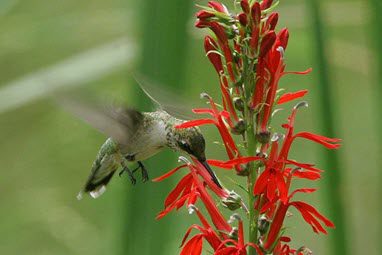
Hummingbird bush plants are bushy plants that reach heights of 2 feet (1 m.), with a spread of about 3 feet (1 m.). The plush leaves and stems are an attractive shade of grayish-green.
The multitude of bright, reddish-orange flowers at stem tips is upright and tube-shaped, making it easy for hummingbirds to reach the sweet nectar.
This versatile perennial is suitable for planting and growing in USDA plant hardiness zones seven and above.
In colder climates, hummingbird plants grow as an annual. It is ideal for containers, hanging baskets, flower beds, or borders.
The Hummingbird Bush, also known as Flame Acanthus, Wright’s Honeysuckle, and Wright’s Anisacanthus, is native to the Edwards Plateau’s rocky regions in west-central Texas.
This shrub to shrub-like grows to 3 to 4 feet vertically and can stretch about 3 to 4 feet horizontally. It thrives well in various soil types, from clay to sand to rock.
It blooms in full sun but can tolerate shade and still pop out a few flowers.
Hummingbird Bush Plant Care
The bush will lie dormant during the winter but will burst forth better than ever when temperatures rise in spring.
The hummingbird bush plant is resilient to most pests and diseases, although it may rot in soggy, poorly drained soil.
Deer prefer to leave this plant alone, probably because of the fuzzy foliage.
Hummingbird Bush Plantis in Acanthaceae or the Acanthus family. This family has close to 2,500 species, roughly in about 250 genera.
In Texas, prevalent species are American Water-Willow (Justicia Americana), Wild Petunias (Ruellia sp.), and Snakeherb (Dyschoriste linearis).
Non-natives such as Shrimp Plant (Pachystachys lutea) and Clockvine (Thunbergia alata) are generally used in cultivation.
One of the most incredible things about this plant is its spreading mechanism!
In late fall, the pollinated flowers make capsules with unique structures attached to the seeds.
These small hook-like outgrowths are called retinaculum. Once the capsule dries, it breaks open, and the retinaculum flings the seed away, enabling the bush to spread.
The capsules can be explosive with the summer heat and launch the seeds many feet away! The young plants are easy to weed out if you so choose.
13 essential reasons why you should plant the Hummingbird Bush (Flame Acanthus)
1. It is a prolific bloomer
Plants with long bloom periods can be challenging to find, especially in the Texas summer heat. On the other hand, Flame Acanthus blooms profusely from midsummer until frost. Grow it in full sun, where it will thrive.
2. It is resistant to heat and drought.
This is the plant for you if you want a low-maintenance plant. Hummingbird Bush thrives in hot weather and requires little water once established.
It can even withstand cold temperatures. It will remain root hardy through Zone 7 in terms of hardiness zones. The plant in San Antonio even survived the massive freeze of February 2021!
It is a deciduous tree (it will lose its leaves during the winter). However, if you prune the dead branches by two-thirds in the spring, it will regrow from its roots. This will result in a denser, fuller shrub.
3. It is not picky about where you plant it.
Hummingbird Bush is not picky about soil type as long as it is well drained. It is also not fussy about the weather. It prefers full sun but can also grow in dappled to partial shade. However, I would not recommend it for areas with complete shade.
4. It is a host plant for butterflies.
In addition to feeding butterflies with nectar, it also serves as a host plant for butterfly caterpillars. It’s a win for me whenever I can add a butterfly or moth host plant to my garden. Learn why having host plants in our yard benefits the ecosystem.
5. It is simple to cultivate in containers.
I enjoy incorporating native plants, as well as annuals, into my patio container pots. Flame Acanthus grows about 3-4 inches tall and wide, making it an excellent choice for a large pot.

6. Hummingbird Bush is an ultra low-maintenance plant.
Virtually thriving off better if you neglect it.
7. Not Demanding Soil
Plant in thoroughly-draining soil, in high sun, and add water during seasons of harsh drought.
8. Fertilizers Not Required
Skip fertilizers and do not plant in overly shady spots, which may avert the plant from blooming.
9. Easy Pruning
Hard clip the Hummingbird Bush preceding spring to boost flowering and new sprouts.
10. Hummingbird Magnet
Hummingbirds adore this plant’s shiny, tubular flowers, so planting it is an excellent way to lure them to your garden.
11. Not depend on frequent Rain
Shortage of rain is commonly not a problem for this hard woody perennial, even though it can swiftly flower after a summer rain splash. It may require a bit of watering for the first year, but once it is established, it seldom needs watering.
12. Amazing Landscape Plant
You will surely appreciate this native plant in your landscape – you and the hummingbirds will enjoy it!
13. Simple to grow and maintain and spectacularly beautiful.
Plant your Hummingbird Bush and admire the results.
Conclusion
Hummingbird Bushes are a fantastic addition to your garden.
Their vibrant flowers, on top of brightening up your yard, will also act as a magnet to hummingbirds drawing them into your garden.


























Comments are closed.